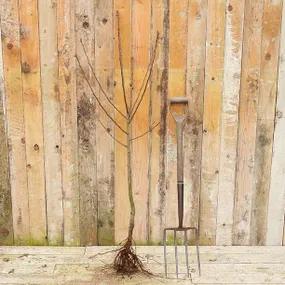Louise Bonne of Jersey Pear Trees
Honest Delivery Prices- Eating: Tangy sweet, soft & juicy.
- Partially Self Fertile.
- Pollination Group A.
- Recommended for frosty sites.
- Crops Late Sept. Stores well.
- RHS Plants for Pollinators
Recommended extras
Description
Louise Bonne of Jersey Pear Trees: Eating, Late Season
A ripe Louise Bonne of Jersey pear is a chunky handful with a yellow - green skin, red blush on the sunny side and a very light coat of russet.
The pink tinged flesh is very juicy and is totally smooth, with no grittiness.
It has a vibrant, tangy sweetness with a faint touch of roses and grapes - delicious.
She is an upright tree. The flowers have some resistance to late spring frost, which is good for the North of England & Scotland.
Browse our range of pear trees, or all our fruit trees.
Delivery season: Bareroot plants are delivered in late Autumn to Spring, about November-March inclusive. Pot grown plants, year round.
Features:
- Partially Self Fertile.
- Pollination Group A.
- Recommended for the North & Scotland.
- Partial tip bearer.
- Harvest in late September & ripen during October & November.
- RHS Plants for Pollinators
Pollination Partners:
These trees can set fruit without a pollination partner, but need one to crop well.
Louise Bonne of Jersey is in pollination group A.
This means that it will cross-pollinate with trees in groups A & B (Except Williams bon Chretien).
Our guide to Pollinating Pear Trees has a full list of partners.
Growing Louise Bonne of Jersey Pears:
Rich soil is important - dig in plenty of good manure and compost before planting.
Soil drainage must be good.
The more sun your trees get the better your crops will be.
Diseases: Louise Bonne has some susceptibility to Scab, which tends to be a problem in warm, damp areas in the West.
With spraying when necessary, this won't be a problem.
Did You Know?
This French variety is from Normandy. Bred in the late 1700s, she is called Bonne Louise or Louise d'Avranches at home. The first trees brought to Britain, during the Victorian era, were grown on the island of Jersey, hence their English name.
She is a former RHS Award of Merit holder.
Pear Tree Delivery Shapes:
Most of our fruit trees are delivered in up to 3 shapes (maiden, bush, and half standard), and you can buy selected varieties as potted mini patio trees: scroll up to see what's in stock.
Maiden: Unbranched tree, the most basic starting size, which you can train into cordons, espaliers, or the forms below (apart from mini patio trees).
Bush: Freestanding tree with a short trunk about 60cm tall. It will grow to about 3m. Ideal for small gardens.
Half-Standard: A freestanding form with a trunk about 120cm tall. It will grow into a full sized, "normal" tree, about 4m. Ideal for orchards, easy to mow underneath.
Cordon: Louise Bonne is a spur-bearer, suitable for cordons and espaliers.
Guide to Fruit Tree Sizing.
7.5 to 12 litres potted non-patio trees are not meant to be kept in pots; they will be fine for up to 12 months until planted in the ground. Keep well watered (but not soaked).
Planting Instructions
Prepare your site before planting:
Improving the soil helps trees establish quickly and be productive for years. Preparing weeks or months in advance gives best results: fill the planting hole back up, don't leave it open to either dry out or fill with water.
- Destroy weeds and grass,
- Dig the soil over, remove stones, then mix in well rotted compost or manure down to the depth of about 2 spades, unless you are on heavy clay:
- On thick clay soil, only dig in some grit to improve drainage and raise the level a little. Then apply organic matter as a mulch over the soil as normal.
Spacing pear trees
- Freestanding bushes: 15-18 feet (5-6m) between trees and rows.
- Freestanding half-standards: 18-30 feet (6-10m) between trees and rows.
In general, allow 1 more metre between rows than between trees along the row.
- Wire-trained cordons: 60-100cm apart along a row.
- Espaliers: 10-18 feet (3.5-6m) apart.
- Watch how to plant a fruit tree for a bush or half-standard.
- To grow a cordon or espalier, you need to install sturdy training wires.
Remember to water establishing trees during dry weather for at least a year after planting.
Accessories:
For bush and half standard trees, a tree planting pack, which includes a wooden support stake & rubber tie (a bamboo cane is enough support for a maiden), and a biodegradable mulch mat, with pegs, to preserve soil moisture stops and prevent weeds.
We strongly recommend using mycorrhizal "friendly fungi" on the roots of all transplanted trees.
Winter wash and grease are effective, organic pest prevention.

 1.webp)
 1.webp)
